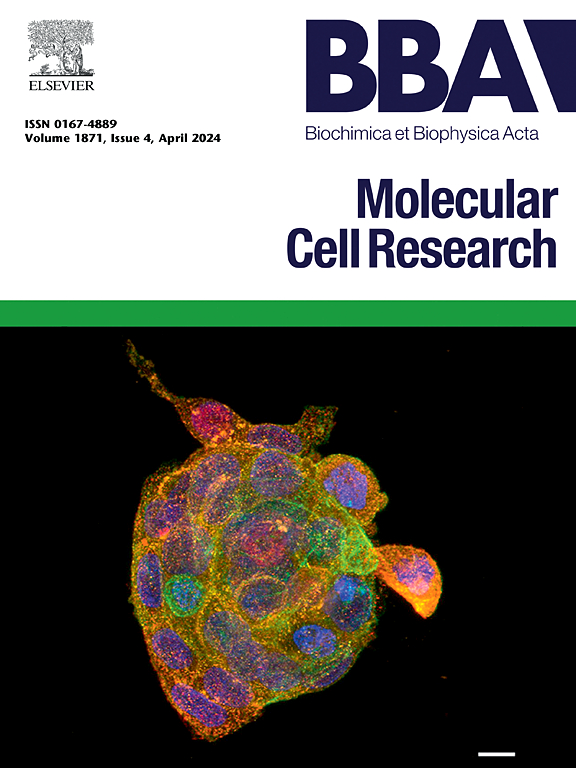CISD2 可抵消抗凋亡 BCL-2 对 ER 线粒体钙传递的抑制。
IF 4.6
2区 生物学
Q1 BIOCHEMISTRY & MOLECULAR BIOLOGY
Biochimica et biophysica acta. Molecular cell research
Pub Date : 2024-10-04
DOI:10.1016/j.bbamcr.2024.119857
引用次数: 0
摘要
CISD2是一种含2Fe2S簇结构域的蛋白质,与沃尔夫拉姆综合征2型、长寿和癌症有关。CISD2是IP3受体(IP3Rs)和抗凋亡BCL-2蛋白三元复合物的一部分,能增强BCL-2的抗自噬功能。在此,我们研究了 CISD2 如何影响 BCL-2 在细胞凋亡和控制 IP3R 介导的 Ca2+ 信号转导中的功能。通过纯化蛋白,我们发现 CISD2 的胞浆区与 BCL-2 的 BH4 结构域之间存在直接相互作用,亲和力达到亚摩尔级。在功能层面上,CISD2的胞浆区作为一种纯化蛋白,并不影响BCL-2抑制BAX孔形成的能力。在细胞环境中,CISD2的缺失并不妨碍BCL-2抑制细胞凋亡。此外,在 Ca2+ 信号传导实验中,CISD2 的缺失并不影响 BCL-2 对 IP3R 介导的 Ca2+ 释放的抑制作用。这些实验综合表明,CISD2 对于 BCL-2 在细胞凋亡和细胞膜 Ca2+ 信号转导中的功能并不是必不可少的。相反,CISD2 的过表达增强了 BCL-2 介导的对细胞膜 IP3R 介导的 Ca2+ 释放的抑制。然而,与 CISD2 和 BCL-2 存在于线粒体相关的 ER 膜(MAMs)一致,在 ER - 线粒体 Ca2+ 转移水平观察到了最显著的影响。BCL-2的过表达抑制了ER-线粒体Ca2+的转移,而CISD2与BCL-2一起过表达则削弱了BCL-2的作用。其潜在机制与ER-线粒体接触位点有关,因为BCL-2减少了ER-线粒体接触位点,而CISD2与BCL-2共同表达则消除了这种效应。这些发现揭示了 BCL-2 和 CISD2 在 ER 和线粒体之间的 Ca2+ 信号纳米域的独特相互作用。本文章由计算机程序翻译,如有差异,请以英文原文为准。
CISD2 counteracts the inhibition of ER-mitochondrial calcium transfer by anti-apoptotic BCL-2
CISD2, a 2Fe![]() 2S cluster domain-containing protein, is implicated in Wolfram syndrome type 2, longevity and cancer. CISD2 is part of a ternary complex with IP3 receptors (IP3Rs) and anti-apoptotic BCL-2 proteins and enhances BCL-2's anti-autophagic function. Here, we examined how CISD2 impacted the function of BCL-2 in apoptosis and in controlling IP3R-mediated Ca2+ signaling. Using purified proteins, we found a direct interaction between the cytosolic region of CISD2 and BCL-2's BH4 domain with a submicromolar affinity. At the functional level, the cytosolic region of CISD2, as a purified protein, did not affect the ability of BCL-2 to inhibit BAX-pore formation. In a cellular context, loss of CISD2 did not impede the suppression of apoptosis by BCL-2. Also, in Ca2+-signaling assays, absence of CISD2 did not affect the inhibition of IP3R-mediated Ca2+ release by BCL-2. Combined, these experiments indicate that CISD2 is not essential for BCL-2 function in apoptosis and cytosolic Ca2+ signaling. Instead, CISD2 overexpression enhanced BCL-2-mediated suppression of cytosolic IP3R-mediated Ca2+ release. However, consistent with the presence of CISD2 and BCL-2 at mitochondria-associated ER membranes (MAMs), the most striking effect was observed at the level of ER-mitochondrial Ca2+ transfer. While BCL-2 overexpression inhibited ER-mitochondrial Ca2+ transfer, overexpression of CISD2 together with BCL-2 abrogated the effect of BCL-2. The underlying mechanism is linked to ER-mitochondrial contact sites, since BCL-2 reduced ER-mitochondrial contact sites while co-expression of CISD2 together with BCL-2 abolished this effect. These findings reveal a unique interplay between BCL-2 and CISD2 at Ca2+-signaling nanodomains between ER and mitochondria.
2S cluster domain-containing protein, is implicated in Wolfram syndrome type 2, longevity and cancer. CISD2 is part of a ternary complex with IP3 receptors (IP3Rs) and anti-apoptotic BCL-2 proteins and enhances BCL-2's anti-autophagic function. Here, we examined how CISD2 impacted the function of BCL-2 in apoptosis and in controlling IP3R-mediated Ca2+ signaling. Using purified proteins, we found a direct interaction between the cytosolic region of CISD2 and BCL-2's BH4 domain with a submicromolar affinity. At the functional level, the cytosolic region of CISD2, as a purified protein, did not affect the ability of BCL-2 to inhibit BAX-pore formation. In a cellular context, loss of CISD2 did not impede the suppression of apoptosis by BCL-2. Also, in Ca2+-signaling assays, absence of CISD2 did not affect the inhibition of IP3R-mediated Ca2+ release by BCL-2. Combined, these experiments indicate that CISD2 is not essential for BCL-2 function in apoptosis and cytosolic Ca2+ signaling. Instead, CISD2 overexpression enhanced BCL-2-mediated suppression of cytosolic IP3R-mediated Ca2+ release. However, consistent with the presence of CISD2 and BCL-2 at mitochondria-associated ER membranes (MAMs), the most striking effect was observed at the level of ER-mitochondrial Ca2+ transfer. While BCL-2 overexpression inhibited ER-mitochondrial Ca2+ transfer, overexpression of CISD2 together with BCL-2 abrogated the effect of BCL-2. The underlying mechanism is linked to ER-mitochondrial contact sites, since BCL-2 reduced ER-mitochondrial contact sites while co-expression of CISD2 together with BCL-2 abolished this effect. These findings reveal a unique interplay between BCL-2 and CISD2 at Ca2+-signaling nanodomains between ER and mitochondria.
求助全文
通过发布文献求助,成功后即可免费获取论文全文。
去求助
来源期刊
CiteScore
10.00
自引率
2.00%
发文量
151
审稿时长
44 days
期刊介绍:
BBA Molecular Cell Research focuses on understanding the mechanisms of cellular processes at the molecular level. These include aspects of cellular signaling, signal transduction, cell cycle, apoptosis, intracellular trafficking, secretory and endocytic pathways, biogenesis of cell organelles, cytoskeletal structures, cellular interactions, cell/tissue differentiation and cellular enzymology. Also included are studies at the interface between Cell Biology and Biophysics which apply for example novel imaging methods for characterizing cellular processes.

 求助内容:
求助内容: 应助结果提醒方式:
应助结果提醒方式:


